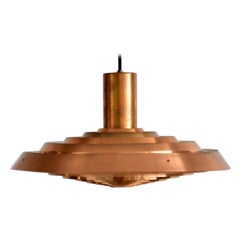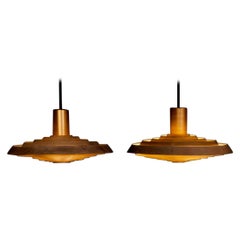Poulsen Tallerken
Recent Sales
Vintage 1960s Danish Scandinavian Modern Chandeliers and Pendants
Copper
Vintage 1960s Danish Scandinavian Modern Chandeliers and Pendants
Copper
20th Century Danish Mid-Century Modern Chandeliers and Pendants
Metal, Aluminum, Copper
Vintage 1950s Danish Mid-Century Modern Chandeliers and Pendants
Copper
Vintage 1950s Danish Scandinavian Modern Chandeliers and Pendants
Copper
20th Century Danish Mid-Century Modern Chandeliers and Pendants
Metal, Aluminum, Copper
Vintage 1950s Danish Scandinavian Modern Chandeliers and Pendants
Copper
Vintage 1950s Danish Chandeliers and Pendants
Chrome, Steel
Poul Henningsen for sale on 1stDibs
The name Poul Henningsen is synonymous with the best and most innovative modern Scandinavian lamps and other lighting. The Danish designer created a signature vocabulary of fixtures with tiered and layered shades in sculptural arrangements that are at once naturalistic and geometric.
Henningsen grew up in a town on the outskirts of Copenhagen and studied architecture at the Technical University of Denmark. He would become a noted art critic, journalist and screenwriter, but his first love was lighting design.
Henningsen’s childhood home was illuminated by oil lamps. When his family switched to electrified lighting, he was alarmed and repelled by the harsh glare cast by an incandescent bulb, and in his late teens he began conducting quasi-scientific experiments to measure which materials and methods best diffused or reflected light to give it a warm brightness. His work came to the attention of the lighting-fixtures firm Louis Poulsen, which sponsored the development of a prototype lamp. The design won a gold medal at the 1925 Paris Expositions Internationales des Arts Decóratifs et Industriels Modernes — from which the term Art Deco derives. The lamp, whose three-part shade is said to be inspired by the arrangement of a dinner plate atop a soup bowl atop a teacup, became the basis for Henningsen’s most successful design, the PH 4/3 desk lamp.
All told, Henningsen would design some 100 lighting fixtures in his career. Some of his most notable creations are hanging lamps, which include the Septima (1929), a pendant composed of seven graduated frosted-glass layers; the Spiral (1942), made of a single ribbon of enameled aluminum; and the Artichoke lamp (1958), whose 70 glass or metal fins in a staggered and graduated arrangement on a central steel frame resemble those of its namesake. The last is likely Henningsen’s masterwork and an icon of mid-20th-century design. Like all Henningsen lighting designs, it is striking, sculptural and — thanks to his insistence on the primacy of the quality of the light cast — superbly functional.
Find a collection of authentic Poul Henningsen table lamps, floor lamps and other lighting on 1stDibs.
Finding the Right chandeliers-pendant-lights for You
Chandeliers — simple in form, inspired by candelabras and originally made of wood or iron — first made an appearance in early churches. For those wealthy enough to afford them for their homes in the medieval period, a chandelier's suspended lights likely exuded imminent danger, as lit candles served as the light source for fixtures of the era. Things have thankfully changed since then, and antique and vintage chandeliers and pendant lights are popular in many interiors today.
While gas lighting during the late 18th century represented an upgrade for chandeliers — and gas lamps would long inspire Danish architect and pioneering modernist lighting designer Poul Henningsen — it would eventually be replaced with the familiar electric lighting of today.
The key difference between a pendant light and a chandelier is that a pendant incorporates only a single bulb into its design. Don’t mistake this for simplicity, however. An Art Deco–styled homage to Sputnik from Murano glass artisans Giovanni Dalla Fina (note: there is more than one lighting fixture that shares its name with the iconic mid-century-era satellite — see Gino Sarfatti’s design too), with handcrafted decorative elements supported by a chrome frame, is just one stunning example of the elaborate engineering that can be incorporated into every component of a chandelier.
Chandeliers have evolved over time, but their classic elegance has remained unchanged. Not only will the right chandelier prove impressive in a given room, but it can also offer a certain sense of practicality. These fixtures can easily illuminate an entire space, while their elevated position prevents them from creating glare or straining one’s eyes. Certain materials, like glass, can complement naturally lit settings without stealing the show. Brass, on the other hand, can introduce an alluring, warm glow. While LEDs have earned a bad reputation for their perceived harsh bluish lights and a loss of brightness over their life span, the right design choices can help harness their lighting potential and create the perfect mood. A careful approach to lighting can transform your room into a peaceful and cozy nook, ideal for napping, reading or working.
For midsize spaces, a wall light or sconce can pull the room together and get the lighting job done. Perforated steel rings underneath five bands of handspun aluminum support a rich diffusion of light within Alvar Aalto's Beehive pendant light, but if you’re looking to brighten a more modest room, perhaps a minimalist solution is what you’re after. The mid-century modern furniture designer Charlotte Perriand devised her CP-1 wall lamps in the 1960s, in which a repositioning of sheet-metal plates can redirect light as needed.
The versatility and variability of these lighting staples mean that, when it comes to finding something like the perfect chandelier, you’ll never be left hanging. From the whimsical — like the work of Beau & Bien’s Sylvie Maréchal, frequently inspired by her dreams — to the classic beauty of Paul Ferrante's fixtures, there is a style for every room. With designs for pendant lights and chandeliers across eras, colors and materials, you’ll never run out of options to explore on 1stDibs.

